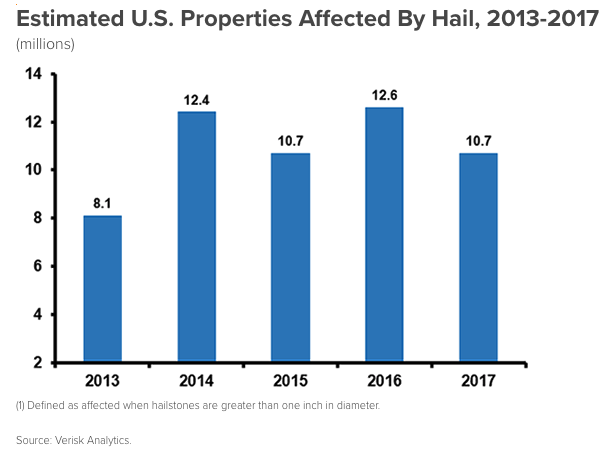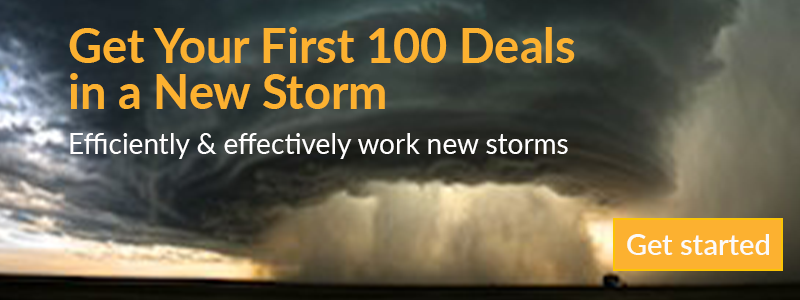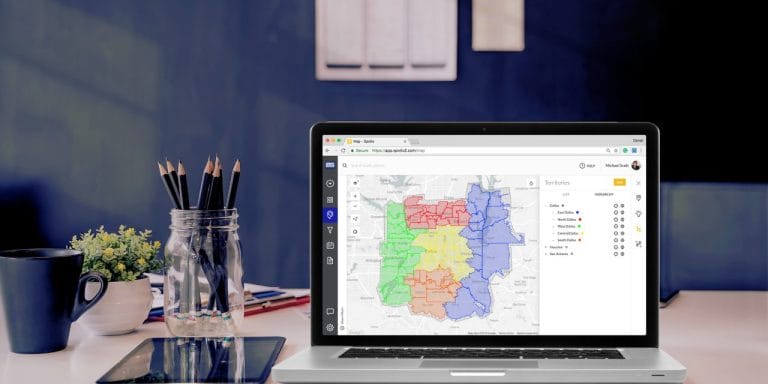With hail season in full force, having a plan of attack is of the utmost importance. The storm restoration industry moves at an exceptionally quick pace due to the seasonality and uncertainty. The number of companies competing in close proximity to each other also adds to the competitive nature.
You have to be ready to dispatch your team almost immediately when a storm hits. It’s critical to have a strategy for where you’re going to send each sales rep following the storm. Being prepared and on top of your game will help you to be first at the door. Getting on the doors before your competitors provides your sales team with an absolutely crucial advantage.

Too many storm restoration companies fail to take a proactive approach to set their team up for success, despite the overwhelming evidence demonstrating the importance that being first has in relation to success, getting out as early as possible is still wildly undervalued.
To help you dominate the new business that comes with the arrival of hail season, we’re going to look at 4 specific strategies to help you beat out the competition and capitalize on this flood of “up for grabs” business.
Table of Contents
- Target the Most Lucrative Areas
- How to Work The Center of the Storm and Beat the Competition
- Why You Should Be Working the Outskirts of the Storm
- Assign Territories Near Your Current Installs
4 Strategies for Working New Storms
1. Target the Most Lucrative Areas
Working the most severely damaged areas is a fairly obvious strategy, but keep in mind that the hardest hit areas with the most damage won’t necessarily always be together. The areas with the greatest amount of damage means there’s going to be plenty of work to go around. You should have already created your Ideal Customer Profile (ICP) so that you can quickly dispatch your team and be able to target those homes specifically.
Using the demographics of your ideal customers will allow you to use market research to easily identify higher quality leads that have a better chance of converting. Market research will provide you with a strategic approach that prevents your team from knocking doors aimlessly.
Lead Machine is the perfect tool to easily filter for the number of homes that match your ideal customer’s market demographics. Lead Machine allows you to filter for certain information like the median home income, home purchase date, year the home was built, single vs multi-family dwelling unit and whether they’re a homeowner vs renter.
Once you click on the Lead Machine tab in your SPOTIO account, you need to map out the area you want to get the market demographics for. Then, Lead Machine will give you the total number of homes. This is how many doors your sales team would have to knock if you weren’t filtering out prospects that didn’t fit your ideal customer profile.

Once you’ve filtered for the information you want, click get these leads and choose who you want to assign them to.
Regardless of the strategy you implement, the most important thing to remember is you need to be tracking every attempt. Because you’re specifically focusing on a certain number of houses that match your criteria, your opportunities are more limited than they would be if you were simply knocking on every door that had damage.
While the number of opportunities might be slightly lower utilizing this approach, you’re better established and set up to convert leads at a much more significant rate. Each house has a greater value associated with it since there’s fewer to go around.
Don’t forget that the fortune is in the follow up, and properly working each territory is mission critical to cashing in on every dollar available.
2. How to Work The Center of the Storm and Beat the Competition
Working at the heart of a fresh storm is always a popular strategy but it comes with a tremendous amount of competition. The companies who usually see the most success with this approach have a sales team with a considerable amount of experience, in addition to sales reps that can back it up and convert at a high rate.
Companies with a high level of brand recognition who have established themselves in the industry also tend to do fairly well attacking the center of the storm. These businesses have spent years building a reputation that consumers have grown to know and come to expect. Larger companies like these generally don’t have to worry about the competition as much as the smaller companies looking to establish themselves do.
A storm restoration company hoping to send their team into the jungle should equip their team with the tools needed to succeed and a pitch that clearly articulates your competitive advantage. The more competitive an area, the more sales pitches a homeowner is likely to hear. Avoid talking above their heads and confusing them more than they probably already are.
Speak in a language that consumers will understand by breaking it down for them in a simple, basic format. Then, leave them something tangible that shows the value of your service. A simple one sheet with data that proves you’ll save them ‘X’ dollars more than the competition, the lifetime value of your product, quotes from happy customers, etc.
Your competitive advantage needs to be unique, and more importantly, something of value to the homeowner.
If the homeowner doesn’t see value in what separates your company from the rest, what’s the point?
3. Why You Should Be Working the Outskirts of the Storm
Some door-to-door companies may not see the value in working the outskirts of the storm or view it as running from the competition, but that couldn’t be further from the truth. When properly worked, the damaged areas on the fringe of the storm can be extremely profitable for your company.
The outer areas of the most severe damage can actually sometimes be more profitable due to the number of door-to-door organizations focusing on the heart of the storm. Working an area that other companies refuse to hit can actually be quite beneficial due to the reduced amount of competition.
With fewer companies to compete against, you’ll be able to establish a greater presence in these neighborhoods. Everyone will see your sales team in the area and know who you are. Your company will be identified rather easily.
While this strategy may seem like a no-brainer off the cuff, there are a couple drawbacks you should be aware of.
The most common challenge is canvassing a larger and more spread out area. The damaged homes aren’t all clustered together like they are in the center of the storm. A more spread out area to cover generally leads to sales reps knocking fewer doors.
Making fewer attempts places a greater importance on being able to set the hook with an effective pitch at the door. Canvassing requires salespeople to know the “bait” that will intrigue the needs and desires of the prospect. Fewer “at-bats” means that measuring performance is significantly more important.
Use your dashboard to measure the 5 must-know door-to-door sales metrics.
4. Assign Territories Near Your Current Installs
One of the most effective strategies to generate more leads and close more deals is to assign territories near your active installs. For this to work, you first need to determine where these homeowners are located geographically. Then, ensure that area has enough homes with damage to justify sending your sales reps there.
Using SPOTIO’s territory management tool you can easily filter for the pins in your account that have the status “Active Install.” This will give you a visualization to create a territory around these customers. Once you’ve identified these areas, you’ll start the process of creating a territory.

Drawing out a territory will present you with the estimated number of homes in that area and give you the option to see all of the territories you’ve created and assigned to your team.
If it turns out there’s not enough value in an area for your entire team to go, don’t just waive the white flag and give up on this strategy completely. Strategically work for referrals as they’re your highest converting & cheapest leads. Referrals are an extremely valuable resource to have at your disposal, and they also make for loyal customers.
83% of consumers who had a positive experience actually say they’re willing to provide sales reps with referrals. Because they close at such a high rate, you can’t ignore working storm damage near their location.
Even if they don’t provide referrals, they can still be used as references to break the ice during an introduction. Kenny Brooks had one of the best sales pitches ever and was the master of referencing customers during his introduction throughout his comedic door knocking career.
Drew Klass is a member of the SVG community who has incredible success canvassing areas near current jobs and outlined his strategy for us below.
“The best advice I can give you is to talk to neighbors while your ladder is still on the house. I have my last ladder set up and go to the neighbor’s house, show them the damage I found on “Bob’s” house, and let them know I’ll be right over as soon I’m done with him.”
He continues…
“Then I walk away. I don’t wait for a “yes – that’s okay.” I just tell them I’ll be over and walk away. I make them tell me no. It works like a charm and I love knocking doors.”
Initiating the conversation is half the battle, and being able to reference someone the prospect may know gives you that spark. Your current customers and active jobs represent a large amount of revenue for your company – Don’t leave that money sitting on the table.
4 Proactive Steps to Determine Where to Work
The most successful door-to-door storm restoration organizations in the industry beat their competition to the doors because of what they do prior to severe weather hitting an area. The heavy lifting is done well before they send their team out in the field.
- Actively track the storm’s path
- Prep your team well in advance
- Talk to suppliers before a storm & ask them to send information once it hits
- Utilize radar detected storm impact alerts
Real-Time Tracking
The best thing you can do to ensure your team is first in the field is to have a live feed of the storm. With how quickly a storm’s trajectory can change, you have to be able to adapt at the last minute.
The information available in today’s technologically advanced society is generally super accurate, but even the best can sometimes be caught off guard. If you’re tracking a storm’s progress and somehow come out on the short end of the draw, you can still send sales reps out to visit different neighborhoods.
Guessing where your team should be working may not lead to the highest level of success, but it beats having them sit around while you come up with a new plan of attack. There’s always homes with damage they can visit, even if they’re more spread out than anticipated. Something is better than nothing, right?
Early Preparation
You can do all the prep work you want ahead of a storm, but if you don’t have anyone to sell, you’re in a bit of a sticky situation. If your team isn’t ready to knock doors with an exact plan, it will be much tougher to get such a high percentage of appointments in the field.
The entire organization should understand how critical being first is to their success.
Being late to the party will reduce the number of opportunities available because another company may already be there. Competitors that beat you to the storm leave fewer potential leads to be split among more canvassers working the same area.
More importantly, not being first means the more qualified prospects with a genuine need are often off the market. The one thing you want to avoid is missing out on high-value targets.
Talking to Suppliers
The suppliers in your local area have access to valuable information that can help you respond quicker. Developing a relationship with them can be extremely beneficial to making sure you’re working the best area.
Suppliers have access to significant resources that will help you get in front of quality prospects. Increasing the quantity of leads your canvassing team produces is good, but giving sales reps opportunities with qualified prospects is better. Ensuring they show up to an appointment with a homeowner that actually has the ability to become a loyal customer is most important.
Radar Detected Storm Updates
The swath maps available have become significantly more accurate, and the technology is constantly getting better. Interactive Hail Maps, for instance, provides live updates through mobile alerts.
There are also free ones that you can get through Weather.gov although they may be more generic than just hail.
If you’re ready to get your team in the field, don’t hesitate. You can always adjust where they’re knocking doors the following day, but you don’t want to lose out on the day when the most opportunities are up for grabs. 16 Real-time alerts are sent directly to your mobile device based on forensic radar detection and public reports made available by the NOAA. The update sent to your phone will provide your distance from the storm’s location.
It’s always a great idea to confirm the storm path that the swath shows by going to the area and looking for signs of damage
Take Advantage of Metrics
Advanced analytics are changing the game for door to door sales organizations. They’re giving companies accurate and reliable data that can be used to set achievable sales targets. Measuring your team’s progress toward these goals is extremely easy, and your metrics are automatically calculated on the SPOTIO dashboard.
Working your numbers in a new storm is essential to your success. Setting a realistic revenue target for each storm is a great way to challenge your sales team. Improved accuracy allows you to determine exactly what you need to do in order to hit these numbers.
You’ll have the ability to track everything from number of doors that need to be knocked each day, to the number of salespeople needed to reach this target. In order to set a challenging, yet realistic target, it’s essential you set SMART sales goals.
Before anyone gets overzealous and starts knocking doors, you have to establish specific measurables. Setting a revenue target of $1 million with an Average Revenue per Sale (ARPS) of $100 and a team of 5 salespeople probably isn’t going to happen. A team of 1,000 working toward this target might have a chance.
The point is you need to understand every component necessary to achieve your end goal.
Number of Sales

An average deal size of $10,000 means your team will need to close a total of 100 deals. Now that you know how many sales you’ll need to reach your goal, you have to determine how many sales reps you’ll need on staff.
Number of Sales Reps
To determine how many salespeople will be required to convert 100 opportunities, use your dashboard to access the average number of deals won by each rep. To make numbers easy, we’re assuming we have one month to reach our goal.10 sales reps on staff isn’t too shabby. Of course they don’t have a close rate of 100%, unfortunately, so you need to find out how many leads need to be generated in order to win the hearts of 100 customers.

Number of Leads Generated
To shorten this example, we’ll assume that sales reps are setting their own appointments. This saves our pretend company a pretty penny by not having to hire canvassers. Determining the number of opportunities needed for reps to close a total of 100 deals is based on your team’s average closing percentage. To make it easy, our team converts leads at a rate of 40%.

Number of Contacts Needed
So you’re trying to get in front of as many Qualified Prospects as you can to convert them over to Leads.
The higher your Qualified Prospect rate the better the area or territory you are working. At a fresh storm the amount of Qualified Prospects you run into should be very high of course depending on where in the storm you are working.
If you’re going to go out and beat the streets you might as well go to areas that have a high concentration of damage and thus a higher concentration of Qualified Prospects.
But how many Contacts do you need to get in front of a Qualified Prospect? We’re going to assume that 85% of the homeowners in the territory you are working are Qualified so to get the amount of Contacts you need to make we’ll divide that number by the Qualified Rate.

Knowing our team has had over 891 people at least answer the door, I’m going to jump ahead a little bit to show the total number of attempts needed to reach our goal of $1,000,000 and 100 sales.
Number of Doors Knocked / Attempts Needed
The number of attempts our team will need to make is largely dependent on our contact rate. Knowing the best time to canvass to maximize contact rates is an extremely simple adjustment to make that will have a significant impact on your profitability.
The average is generally between 25% – 35%. If you’re not achieving this rate, you should look at switching the times your team is canvassing.
To demonstrate the importance of getting in front of homeowners, we used two examples with contact rates that are pretty average.

By simply looking at my dashboard, I noticed my team’s contact rate was 10% higher during certain times. The result is sales reps knocking 1,000 less doors.
I also just saved some serious coin and improved my profitability since sales reps didn’t work as many hours in the field. I’m happy, and my team is happy.
It’s a win-win.
To ‘Sum’ It Up
Did I mention this data is automatically calculated for you…?

Using the data and analytics available to us, we’ve been able to determine the sales activities that need to be completed to achieve our revenue target and maximize profitability. To accomplish our revenue goal of $1,000,000 – Check out the final results:

In a storm environment, many companies put a lot of emphasis on the number of attempts their team makes per day. They also incentivize this metric as well. You can provide a small incentive to drive production, but you can’t pay out on this metric alone.
The risk with this strategy is that many on your team will probably go out and just knock doors without focusing on converting them into deals. They’re so focused on just hitting doors that they downplay getting leads and sales.
We see this quite often with our existing customers, and it’s no different than an inside sales organization. The initial focus needs to be on the number of doors they knock once they get in a new area, but it needs to quickly shift to quality conversations.
When you shift your focus to quality conversations, you know that having enough of those will get you to the number of deals you need. At the end of the day, it may take 33% fewer attempts to get the sales volume needed depending on all the other factors in your funnel.
Knock the number of doors needed to have the number of quality conversations that will lead to results.
______
Questions or comments? Contact SPOTIO at [email protected] or comment below.
SPOTIO is the #1 field sales automation and performance management software that will increase revenue, maximize profitability, and boost sales productivity.
Want to see a product demonstration? Click here to see how SPOTIO can take your sales game to the next level.





